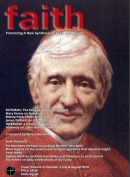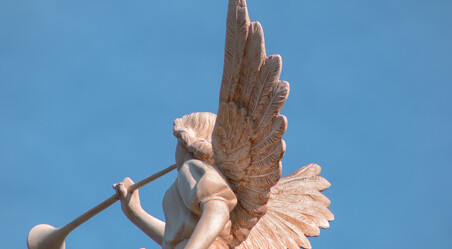Letters To The Editor
FAITH Magazine March-April 2003
Roland Walls and The Scots Confession
Dear Fr Editor
Catholic theology does not make “a distinction between the mystical body of Christ and the Church visible on earth” as Fr Walls claimed in his article (Faith Nov/Dec 2002). The idea is foreign to the whole Catholic tradition, which is preserved in the Orthodox Church also: “There is only one Christ and so there can only be one Body of Christ. Nor is this unity ideal and invisible; Orthodox theology refuses to separate the ‘invisible’ and the ‘visible’ Church, and therefore refuses to say that the Church is invisibly one but visibly divided.” (T.Ware, now Bishop Kallistos, The Orthodox Church, 1964, 249). Quoting Satis cognitum: “By the very fact of being the body the Church is visible,” says Pius XII. “It is therefore an aberration from divine truth to represent the Church as somethingintangible and invisible, as a mere ‘pneumatic’ entity joining together by an invisible link a number of communities of Christians in spite of their difference of faith” (Mystici corporis). Lumen gentium teaches that “Christ… has founded… his Holy Church”; “has made her visible framework… the dispenser of grace and truth”; “she is a society equipped with hierarchical organs and the Mystical Body of Christ, a visible assembly and a spiritual fellowship”; “we must not think of the Church as two substances, but a single, complex reality, the compound of a human and a divine element” (n.8). Fr. Walls attributes to this document the teaching that “the Mystical Body of Christ, which although the same entity as the visible Church in which it subsists is nonetheless to be distinguished from theChurch ‘constituted and organised as a society in the present world’”. It makes no sense to me. If he thinks that the latter is “distinguished” from the “visible Church” what is the difference? If, on the other hand, it is “distinguished” from the “Mystical Body of Christ” how can the latter be “the same entity as the visible Church”? We Catholics believe that the Catholic Church (“Roman”, if you wish) is, as Pius XII puts it: the “true Church of Christ ”, His “Mystical Body”. Lumen gentium n. 8 (above) and Orientalium ecclesiarum n. 2, confirm it; it is implied in much of what the Council teaches elsewhere, particularly in the doctrinal sections (nn. 2-4) of Unitatis redintegratio. The word “subsists” can make confusion. But, if one trusts Hans Hung’s comment (The Church, 1968, p.283)that the “fomulation was purposely left as vague as possible, so as not to stand in the way of further “theological investigation”, it is clear that it cannot be a clue for the interpretation of the Church’s authentic teaching. Yours faithfully,
M. Skarpa
Hawes Road, Bromley ' Kent
Dear Fr Editor,
I found Fr Walls’ article interesting, however he did seem to jump over a rather significant part of the Scots Confession. Namely, the little bit called The Horrible Harlot which describes the Catholic Church as the harlot and the Pope as the anti-Christ. Calvin did not, after all, see the Catholic Church as a Christian body but rather as a satanic one. Yours faithfully,
David Idden
Mt. Rivers Close, Carrigaline, Co. Cork, Eire .
Philip Vander Elst and Evolution
Dear Fr Editor,
The little editorial disclaimer at the beginning of Philip Vander Elst’s article in the last issue (Faith Jan/Feb 2003) regarding his position on evolution was a trifle sad. The Church and Christians generally still smart from accusations levelled against our slow acceptance of Darwinian theory; one of the first toys that baby science threw out of the cot for us to pick up and since become one of the key tenets of the modern scientific “belief system”. But there is no need to distance oneself from keen alternative observations such as those proposed by Vander Elst in his article. If I may digress a little: a regular pastime that I enjoy after hearing each enthusiastic new TV report of an endeavour to communicate with deep space civilisations (which we are now told must surely exist) is toimagine some ‘alien’, hugely remote and distant from us in every way, twiddling with a radio set! There is a huge arrogance (or is it desperation) in thinking that our clumsy inventions are some sort of universe wide standard. But there also lies behind this belief in ‘aliens’ a significant and increasingly accepted basis theory, namely that species of life can come into being and evolve independently of each other. Species of being need not have a common source in time or biological terms. Darwinian theory, taken to its origins, indicates that life on earth has a common ancestor. This is not necessarily true, even though thinking Catholics are terrified of saying so. I should have thought that a moderate, modern and rational atheistic mind could well accept that the physical matter ofthe universe fully contains the potential for life and needs only the stable incubator to begin a life process, and that any number of these life processes could begin at the same time, each distinct from the next within the correct environment. Call these ‘created’ if you like or ‘made from nothing’. Preposterous as this may sound, it is as likely a beginning for life as is earth’s entire community of beings evolving in the ‘standard’ way in an impossibly short time period from a single source. Darwinism is an explanation dripping with nineteenth century scientific method. Perhaps I am being facetious. What is certain though is that Holy Science itself has cast large shadows over her own pronouncements about our origins. The more we learn, the more evolution as an observed processbecomes distinct from our origins which are still highly mysterious. An informed Christian should not confuse the two or shy away from “telling it as it is”. Vander Elst’s boldness needs no aside. Thank you for an always wonderful magazine. Yours faithfully
James Gillick
Spaw Lane, Louth, Lincs
An Appreciation
Dear Fr Editor,
Your editorial in the last issue of Faith (Jan/Feb 2003) was the most heartening thing I have read in a very long time. God be with you in your important apostolate. Yours faithfully,
Isabel Carey
Caithness Place, Edinburgh .






